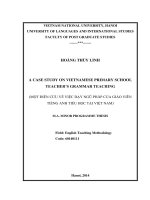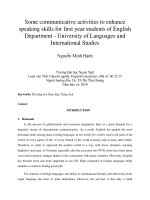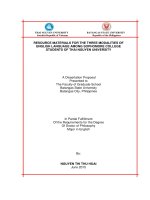IMPROVING TEACHING PROFICIENCY FOR PRIMARY SCHOOL TEACHERS OF ENGLISH
Bạn đang xem bản rút gọn của tài liệu. Xem và tải ngay bản đầy đủ của tài liệu tại đây (5.62 MB, 103 trang )
IMPROVING TEACHING PROFICIENCY
FOR PRIMARY SCHOOL TEACHERS
OF ENGLISH
September, 2012
Nguyen Quoc Tuan (MEd/MA)
Vietnam National Institute for Educational Sciences
Phone : 0912 144 655
Email :
11
Topic 1: TEACHING ENGLISH FOR YOUNG LEARNERS
1. Characteristics of young learners
Imaginative (somtime more than adults)
Active (physically)
Curious
Playful
Talkative
Sensitive
Sense of humour/fun
Easy to remember/easy to forget
Difficult in concentrate/focus for long time
Good at immitating (action/pronunciation)
Lack of self-motivation
22
2. Learning styles
Visual
Learner learns best through seeing.
Auditory
Learner learns best through hearing
Kinaesthetic
Learner learns best through using the body
Group
Learner learns best through working with others
Individual
Learner learns best through working alone
Reflective
Learner learns best when given time to consider
choices.
Impulsive
Learner learns best when able to respond
immediately
33
3. Advice (1)
Pick up the language naturally (by chance)
Be interested in meaning, not grammar/words
Chunks/phrases (How are you? Fine, thank you. And you?,
shut up, point to the door)
Learn effectively through chants, songs, activities, games,
stories.
Auditory-visual
Having fun
Making mistakes
44
3. Advice (2)
Change activities/pace/focus reguilarly
Stir and settle alternatively
Copying and drawing/colouring
Organisation and routine/rules
Develop study skills
Movement – physical tasks
Be kind but firm
Be encouraging
55
TOPIC 2: CURRICULUM, TEXTBOOKS, TEACHER’S GUIDE, WORKBOOKS,
TEACHING-LEARNING AIDS
I. CURRICULUM
Four main approaches
Objectives:
Communicative approach
Contents:
Thematic approach
Methodology:
Learning-centered approach
Outcomes:
A1 of CEFR
(Common European
Framework of Reference for Languages:
Learning, Teaching, Assessement)
66
1. Objectives
Spoken
(Dicisive)
LISTENING
LISTENING - SPEAKING
(Interactive)
SPEAKING
Written
(Supportive)
READING - WRITING
Language
(Conditional)
PHONETICS, VOCABULARY, GRAMMAR
77
2. Contents
Themes: 4
Me and my friends
Me and my school
Me and my family
Me and the world around
Topics:
5 topics per theme – unit
Core content:
Communicative Competences
Language
elements:
Phonics
Vocabulary
Sentence patterns/grammar
88
Communicative competence
involves at least 4 components:
- Linguistic competence: the knowledge of the rules of the
language and ability to produce correct utterances;
- Sociolinguistic: the knowledge and ability to understand and
use language appropriately in varied settings;
- Discourse: the knowledge and ability to produce and
understand a variety of different types of text used for
different communicative purposes
- Strategic: the ability to maintain communication through
using different kinds of strategies
99
3. Methodology: Learning-centered approach
Methods: methods + procedure + techques/activities
Methods of teaching-learning (the language skills and
language elements)
Procedures
Techniques/activities
Modes: Interactions
Interactions between teachers/students, among students
(pairs/groups),
Interaction with textbooks/materials
Learning through playing, singing, chanting
10
10
Learning strategies: Learning how to learn
There are two main classes of language learning strategies, direct and
indirect, further subdivided into six groups:
Memory (Ghi nhớ): helping students store and retrieve information;
Cognitive (Nhận thức): enabling learners to understand and produce new
language by many different means;
Compensation (Bù đắp): allowing learners to use the language despite
their often large gaps in knowledge;
Meta-cognitive (Siêu nhận thức): allowing learners to control their own
cognition;
Affective (Tình cảm): helping to regulate emotions, motivations and
attitudes;
Social strategies (Chiến lược giao tiếp): involving learning by interaction
with others
These groups can be subdivided into a total of 19 strategy sets, with the
whole strategy system incorporating 62 strategies.
11
11
4. Learning outcomes
5 skills:
Spoken interaction
Spoken production
Listening
Reading
Wriitng
4 domains: Me and my Friends, Me and my School, Me
and my Family, Me and the World Around
Standards: A1 of CEFR:
Grade 3: A1.1
Grade 4: A1.2
Grade 5: A1.3
12
12
II. TEXTBOOKS
1. Approaches:
Communicative: Spoken interaction, spoken production,
listening, reading, writing
Language
elements:
Integration:
Involved in the texts when needed
Cooperation:
Among Vietnamese authors + Vietnam
EPH + Macmillan Pubishing House +
British Council
Among language, artwork and recording
13
13
2. Structure
Book maps:
Competences
Sentence Patterns
Vocabulary
Phonics
Units:
Lesson 1, Lesson 2, Lesson 3
Reviews:
Vocabulary + Listening + Reading, +
Writing + Speaking
Glossary:
14
14
3. Contents of the units
Lesson 1
Lesson 2
Lesson 3
Language competence 1
L C 1+ 2
Language competence
2
1. Look, listen & repeat
1. Listen and repeat
1. Listen and repeat
2. Look and say
2. Listen and …
2. Look and say
3. Talk
3. Read and …
3. Write
4. Chant/Song/Game
4. Chant/Song/Game
4. Chant/Song/Game
15
15
4. Teaching plan
UNIT:
Lesson 1:
Period 1 1. Look, listen and repeat
2. Look and say
Period 2 3. Talk
4. Chant or Song or Game
Lesson 2:
Period 3 1. Listen and repeat
2. Listen and …(complete/ tick/ match, answer, ..)
Period 4 3. Read and …. (complete/ tick/ match, answer, ..)
4. Game or Song or Chant
Lesson 3:
Period 5 1. Listen and repeat
2. Look and say
Period 6 3. Write
4. Game or Song or Chant
16
16
III. TEACHER’S GUIDE
1. Approaches
2 versions:
English and Vietnamese
Procedures:
G.I.P.O = Goal→Input→Procedure→ Outcome
Goal: Competences
Input: New languages
Procedure: following the contents of the
student’s books
Outcone: Answer keys
Mode:
wholeclass→individual→pairs→groups
→wholeclass
17
17
2. Contents
PART I: SKILLS and LANGUAGE TEACHING
Teaching listening/ Teaching speaking/ Teaching
reading/ Teaching writing/ Teaching pronunciation/
Teaching voicabulary/ Teaching grammar/ Optional
activities
(TPR,
chants,
rhymes,
songs,
pair/groupwork)
PART II: TEACHING INDIVIDUAL UNITS
General view
Procedure
18
18
IV. WORKBOOKS
1. Approaches: Revision, Practice, Enhance
2. Contents
A. PHONICS
1. Sounds in words
2. Words with sounds in sentences
B. VOCABULARY
1.
2.
1.
2.
1.
2.
C. SENTENEC
PATTERN
D. READING
E. WRITING
Words
2. Words in sentences
Functions
2. Functions in contexts
Dialogue
2. Passage
Writing about topics with guidence/
suggestions
19
19
V. TEACHING-LEARNING AIDS
1. Approaches
Focussing on audio-visual seneses
Stressing direct learning
Increasing intensive learning
Enhancing activeness, creactiveness, self-confidence/independence
2. Contents: Five minimum teaching-learning aids
The recording (CD/DVD)
Posters (one poster/unit)
Pupptets (Main characters)
Word Cards (about 80/grade
Letters (English alphabets and numbers
20
20
TOPIC 3: METHODS OF TEACHING AND LEARNING
I. METHODS OF TEACHING-LEARNING LANGUAGUE SKILLS
1.Method of teaching-learning spoken interaction
2.Method of teaching-learning spoken production
3.Method of teaching-learning listening
4.Method of teaching-learning reading
5.Method of teaching-learning writing
Or 3 groups:
1.Method of teaching-learning spoken interaction
2.Method of teaching-learning listening / reading
3.Method of teaching-learning spoken production / writing
21
21
I. Method of teaching-learning spoken interaction
1. Characteristics
Spoken interaction means conversations or dialogues:
direct exchanges of information between speakers &
listeners
The quality of spoken interactions depends on:
• How to start, sustain and end the conversations /
dialogues
• The number of exchanges
• The quality of the questions and answers
22
22
2. Procedure:
Initiation → Core activity → Follow-up (I.C.F)
Procedures
Tasks
Initiation:
• Introducing the topic (who, what, where, when, ..)
• Explaining the competence (sentence patternces/
language function)
• Listen to the dialogue
Core Activity:
• Listen and repeat the dialogue
• Practicing the dialogue (sentence patterns, new
words)
• Applyiing the sentences patterns/new words in
different contexts/ situations
Follow-up:
23
23
3. Examples: Lesson 1, Unit 11, English 4/Part 2
Initiation: Whole class
•Pupils look at the picture (P6). Help them to identify that Peter and
his father are at home, talking about the time.
•Explain the phrase go for a walk.
•Pupils listen through the recording once of twice
Core activities: Whole class
•Pupils repeat the recording, line by line
•Pupils listen to the recording and repeat the dialogue.
•Divide class into pairs/groups. Pupils repeat Peter’s and the dad’s
parts.
Follow-up: Pair/goupswork
•Repeat the step, but swap the roles.
•Check to make sure pupils can repeat and understand the
dialogue.
24
24
4. Tips of teaching spoken interactions
Introduce some humour into dialogues
Keep dialogues simple. Shorten long sentences.
Create clear context and the purpose for dialogues should be
easy to work out
Turn the dialogue into role-plays
Demonstrate the activity the first time you use it
Have the students do the role-play in pairs /small groups first
Role-play in front of the class
Create a non-threatening climate
Substitute key words
Get the students to make the dialogue longer by adding two or
more lines.
25
25









